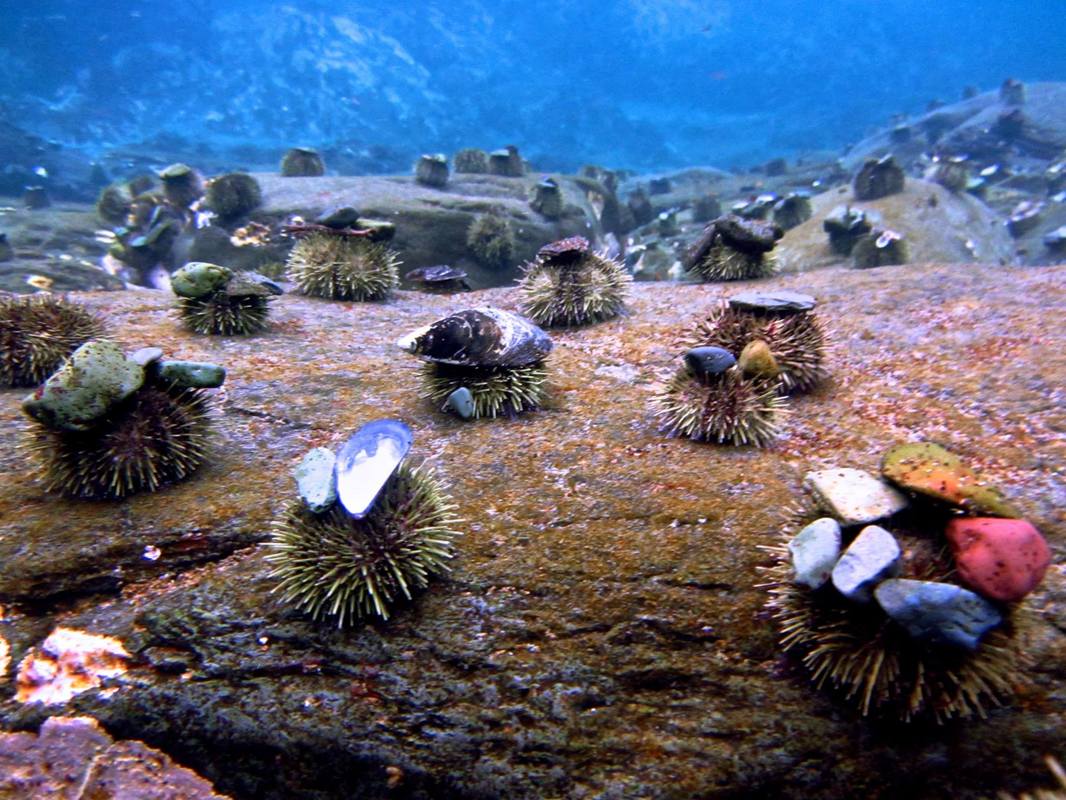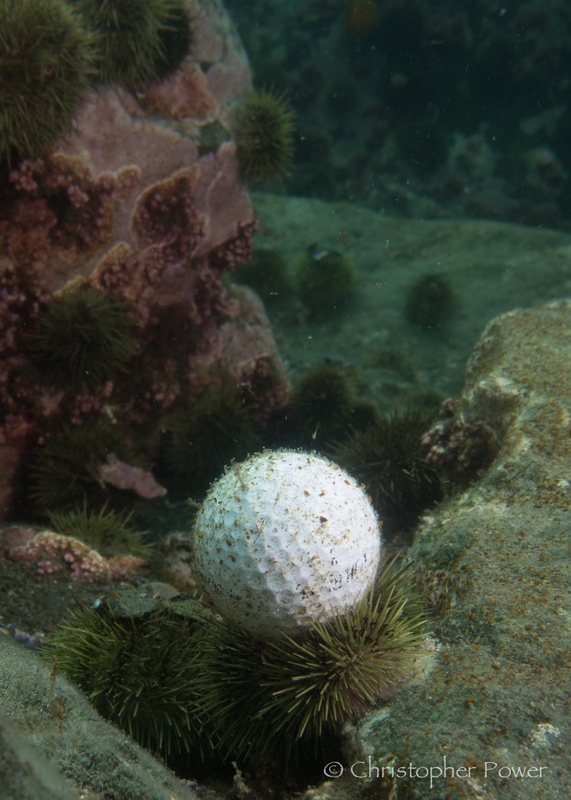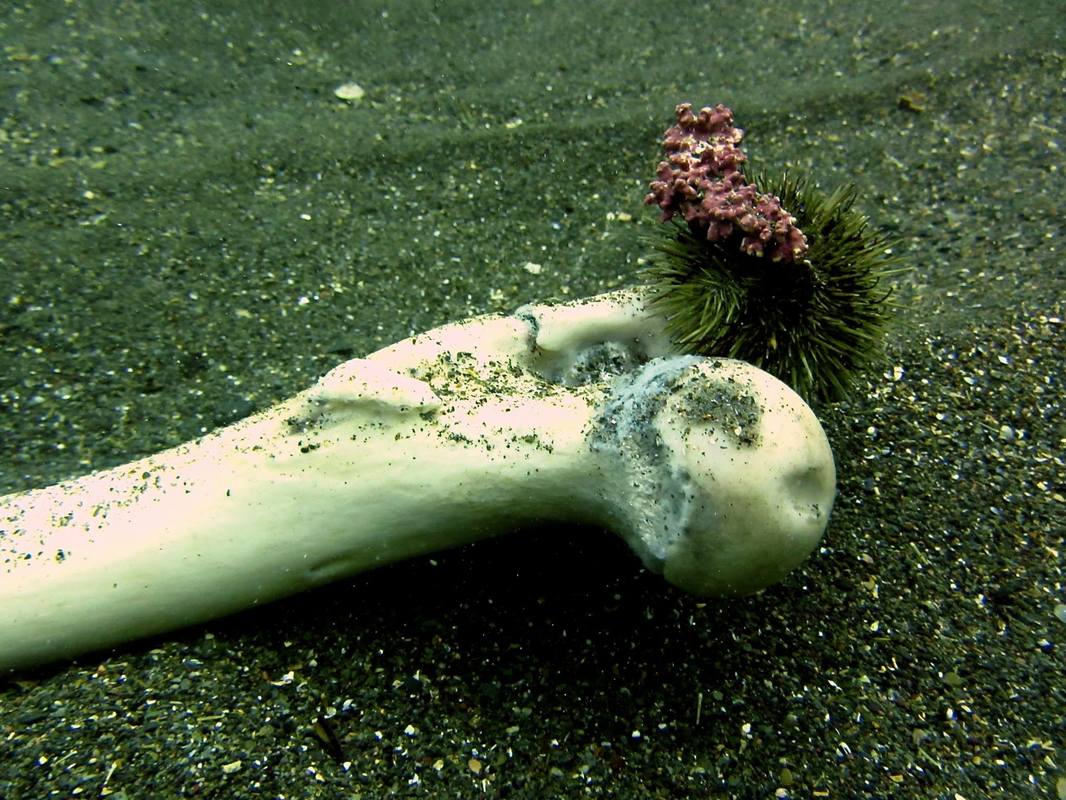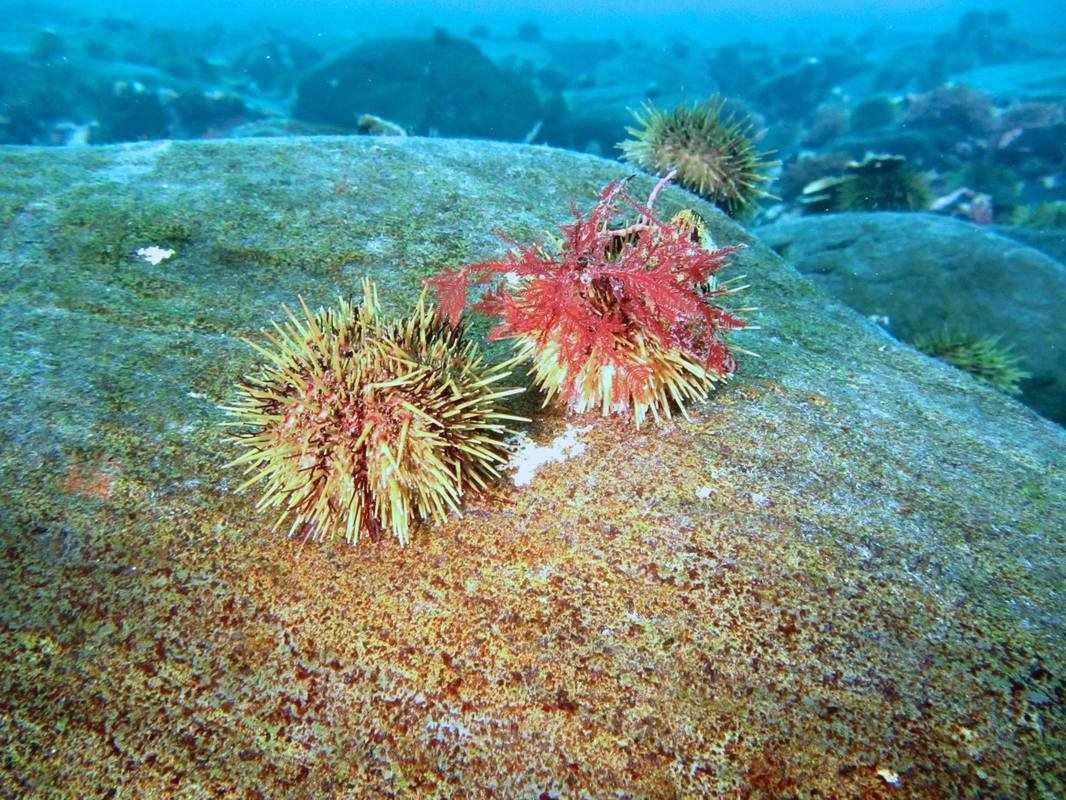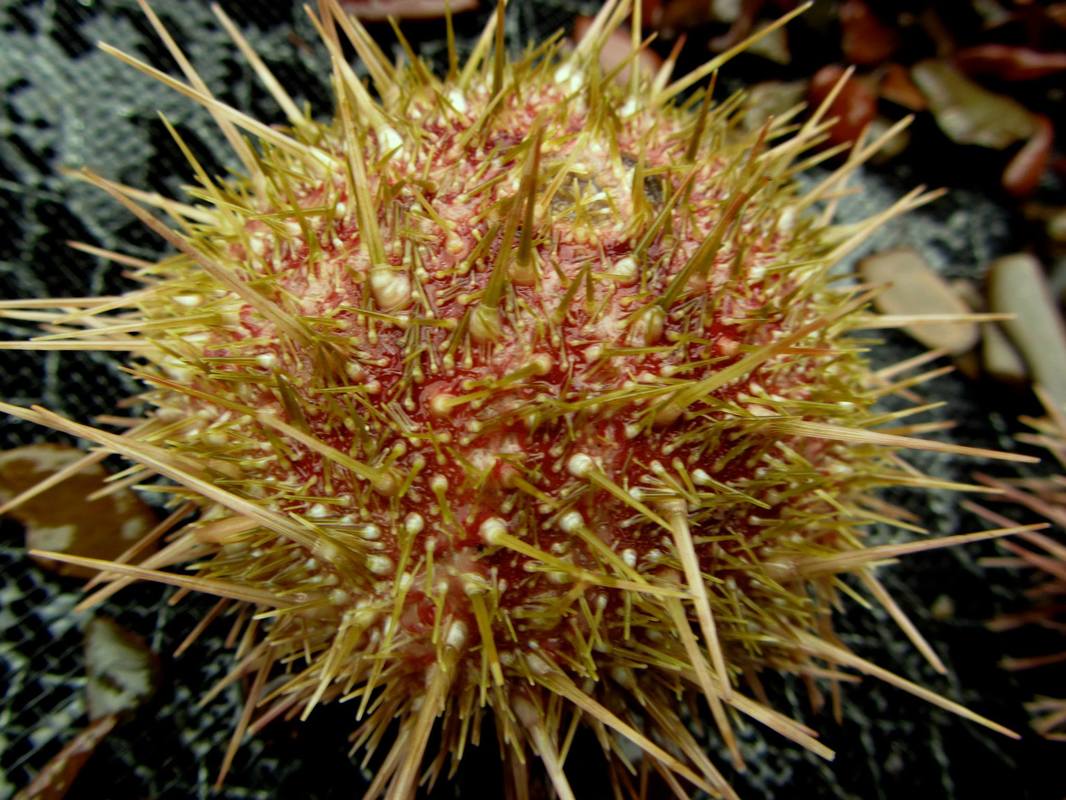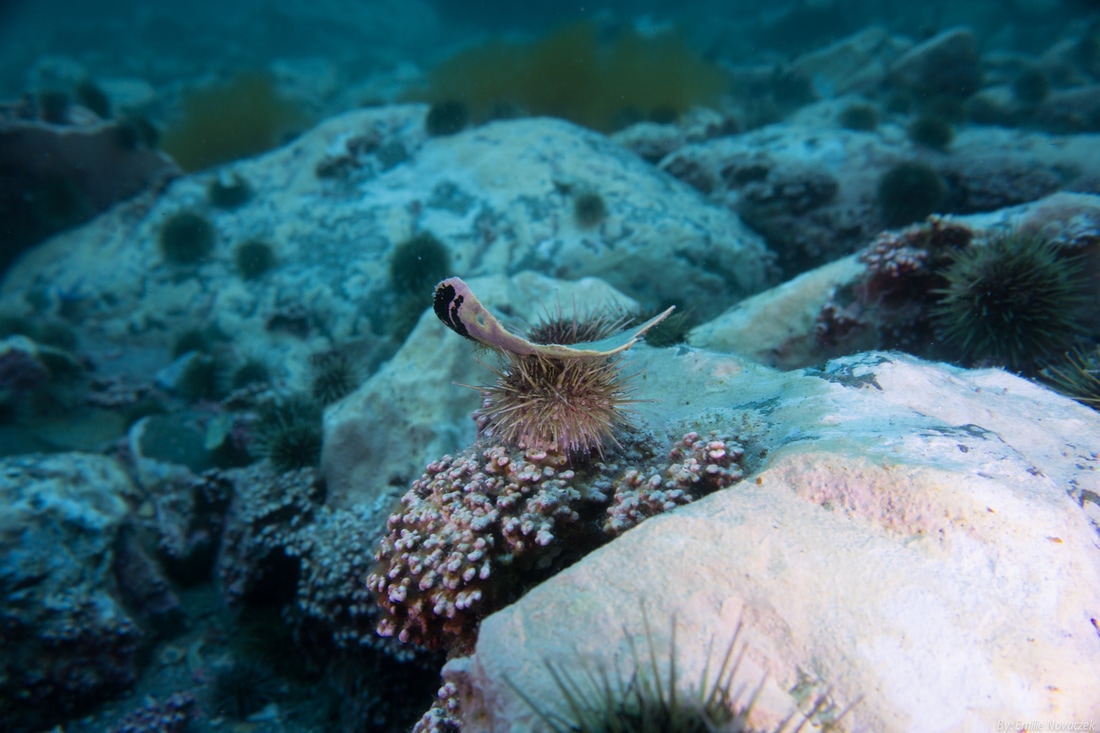|
Text and Photos by Emilie Novaczek Spoon Cove, Newfoundland There’s lots to see while SCUBA diving the North Atlantic coast; long-toothed wolffish, scowling eelpouts, graceful winter skates, fields of magenta coralline algae, and if you’re lucky, a glimpse of a humpback whale in the distance. In all that diversity, the sea urchins are some of my favourites – and it’s all about the hats. The most common urchin in Newfoundland, and throughout the Maritimes, is Strongylocentrotus droebachiensis, a bit of a mouthful for the unassuming green urchin. We see hundreds of green urchins on every dive, and in the shallows, we find them covered with anything they can get their tube feet on: rocks, shells, even the odd golf ball. St. Thomas Cove, Newfoundland. Photo by Christopher Power Echinodermata refers to the phylum of animals that includes seastars, sea cucumbers, sand dollars, crinoids, and our hat-wearing urchins. Echinoderms share a few key features, including a couple that sound like superheroes: Wolverine’s regeneration and Spiderman’s ability to scale smooth surfaces at any angle. We’ll get back to regeneration later on. Echinoderms move around the seafloor (or simply move food to their mouth) using hundreds of sticky tube feet. These feet are part of the water-vascular system, a network of seawater-filled tubes. Urchins move using the tube feet on their ventral side by contracting small muscles that force water into the tubefoot to take each step. The end of each tube foot is very, very sticky. They are often described as suction cups, however recent research[1] indicates that echinoderms likely use a bio-adhesive, rather than suction, to achieve their Spiderman-like climbs. Urchins also use these sticky tube feet to pick up and hold onto rock, shells, golf balls, and other treasures. But why? Spoon Cove, Newfoundland Behavioural ecologists call urchin hats “covering behaviour”. That name is related to the first and most prevalent hypotheses about the phenomena: the urchins are covering themselves to provide shelter from sunlight, predators, or both. Experiments conducted on Paracentrotus lividus, the purple sea urchin common to the Eastern Atlantic Ocean, confirmed the light hypothesis. Researchers in Ireland found that when the urchins were exposed to full spectrum UV light, more individuals would pick up their hats and/or move to the shady corners of their tanks to avoid harmful UV radiation[2]. Around the same time, another scientist in California was studying covering behaviour of Pacific rose flower urchins, Toxopneustes roseus[3]. The rose urchin study wasn’t conducted in a lab; instead urchin behaviour was observed in their natural habitats. What they found was that at the sample site with the greatest wave energy, there was also the most covering behaviour among the urchins. Harbour Grace, Newfoundland So which is it? Sun safety? Or are these hats more like seat belts and kneepads, weighing urchins down and protecting them from wave damage? On this side of the Atlantic, researchers tested several factors simultaneously to trace the covering behaviour to it’s source. In a laboratory, green urchins were exposed to common predators, wave surge, waving algae blades, and sunlight[4]. As it turns out, the predators were a bust: their presence had no significant impact on the rate of covering behaviour. The hats are not camouflage. Urchins may have some scary looking spines, but they still have predators! Like the Irish purple urchins, green urchins exposed to UV light were found to cover up more. However, UV exposure wasn’t the most important factor. This study found that green urchins on the east coast of Canada, like rose urchins in California, wore more hats when they were exposed to wave surge, and/or in contact with moving algae blades. Not all urchins wear hats though; the Canadian study found that smaller urchins were more like to cover up. Seastars can regenerate lost arms, sometime many at a time (see? I told you we’d get back to this). Though it’s less dramatic, urchins are constantly regenerating lost and broken spines. But regeneration takes energy. It may be a safer bet, particularly for a small urchin who is vulnerable to dislodgement and damage, to pick up some extra weight and a little sun protection at the same time. Bacon Cove, Newfoundland [1] More information on tube feet: http://echinoblog.blogspot.ca/2013/01/echinoderms-dont-suck-they-stick.html [2] Verling et al. 2002: http://link.springer.com/article/10.1007%2Fs002270100689?LI=true [3] James 2000: http://link.springer.com/article/10.1007%2Fs002270000423?LI=true [4] Dumont et al. 2007: http://www.sciencedirect.com/science/article/pii/S0003347207000796 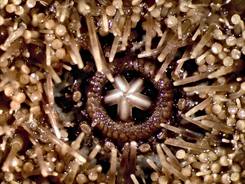 Emilie is a marine conservation biologist and PhD candidate at the Memorial University of Newfoundland. She is also the Chair of the Biology Graduate Student Association at Memorial. Emilie knows all about catch-and-release aquariums as she has been a volunteer scientific diver for the Petty Harbour Mini Aquarium for the past four years. t: @maptheblue Thanks so much for writing this post Emilie. We can only hope you'll be able to join us on a Back to the Sea dive one day! P.S. Another thing we love about Emilie are her awesome pictures, like this one of an urchin's mouth, known as Aristotle's Lantern.
6 Comments
Julieta
11/23/2020 09:02:49 pm
I saw a picture of sea urchins wearing hats on Reddit and became curious to learn more. Thank you for a clear, concise, and well written description of this behaviour!
Reply
Wenonah
11/24/2020 11:44:14 am
That's why I came too! It was an informative little read.
Reply
Maxwel Antonio
10/31/2021 04:39:29 am
I need to know more urchins
Reply
Leave a Reply. |
Categories
All
We send blog recaps with in all our quarterly newsletters!
|
